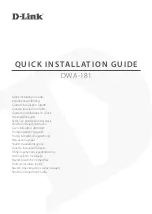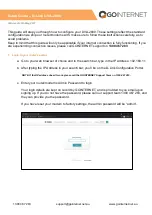
REGULATORY INFORMATION
28
Dragonfly
TM
MTQ-L4G1 Device Guide
Rule Parts
Frequency Range
Output Watts
Frequency Tolerance Emission Designator
27
2575.0 - 2615.0
0.3936
0.1 PPM
8M91G7D
27
2506.0 - 2680.0
0.4842
0.1 PPM
17M9G7D
27
2506.0 - 2680.0
0.342
0.1 PPM
17M9W7D
27
2501.0 - 2685.0
0.4853
0.1 PPM
8M91G7D
27
2498.5 - 2687.5
0.3451
0.1 PPM
4M50W7D
Single Modular Approval. Power listed is ERP for part 22 and part 27 below 1 GHz, EIRP for part 24 and part 27
above 1 GHz. Approval is limited to OEM installation only. Compliance of this device in all final host configurations
is the responsibility of the Grantee. This device is to be used only for mobile and fixed applications. OEM
integrators must be provided labeling requirements for finished products. This grant is valid only when the device
is sold to OEM integrators and the OEM integrators are instructed to ensure that the end user has no manual
instructions to remove or install the device. Separate approval is required for all other operating configurations,
including portable configurations with respect to 2.1093 and different antenna configurations. The module
antenna(s) must be installed to meet the RF exposure compliance separation distance of 20 cm and any additional
testing and authorization process as required. Co-location of this module with other transmitters that operate
simultaneously are required to be evaluated using the FCC multi-transmitter procedures. The antenna installation
and operating configurations of this transmitter, including any applicable source-based time-averaging duty factor,
antenna gain, and cable loss must satisfy MPE categorical Exclusion Requirements of Part 2.1091. Users must be
provided with instructions and transmitter operating conditions for satisfying RF exposure compliance. RF exposure
compliance may need to be addressed at the time of licensing, as required by the responsible FCC bureau(s),
including antenna co-location requirements of Part 1.1307(b)(3). This module can only be used with a host antenna
circuit trace layout design in strict compliance with the OEM instructions provided. This device supports: LTE of 1.4,
3, 5, 10, 15, and 20MHz bandwidth modes for LTE Band 2, 4 and 25; and LTE of 1.4 , 3, 5 and 10MHz bandwidth
modes for LTE Band 5,12 and 26 (814-824MHz),LTE of 5, 10, 15 and 20MHz bandwidth modes for LTE Band 7, 38
and 41; LTE of 5 and 10 MHz bandwidth modes for LTE Band 13; LTE of 1.4, 3, 5,10 and 15MHz bandwidth mode
for LTE Band 26(824-849MHz).
The allowed maximum antenna gain including cable loss in a mobile-only exposure condition must not exceed:
8dBi in WCDMA Band 2/LTE Band 2/7/25/38/41; 5dBi in WCDMA /LTE Band 4, and 8.6dBi in GSM850;10.19dBi in
PCS1900; 9.42dBi in WCDMA Band 5; 9.41dBi in LTE Band 5; 8.7dBi in LTE Band 12; 9.16dBi in LTE Band 13; 9.36dBi
in LTE Band 26(814-824); 9.41dBi in LTE Band 26(824-849).
This device contains functions that are not operational in U.S. Territories. This filing is only applicable for U.S.
operations.
Industry Canada Class B Notice
This Class B digital apparatus meets all requirements of the Canadian Interference-Causing Equipment Regulations.
Cet appareil numérique de la classe B respecte toutes les exigences du Reglement Canadien sur le matériel
brouilleur.
This device complies with Industry Canada license-exempt RSS standard(s). The operation is permitted for the
following two conditions:
1.
the device may not cause interference, and
2.
this device must accept any interference, including interference that may cause undesired operation of
the device.
















































